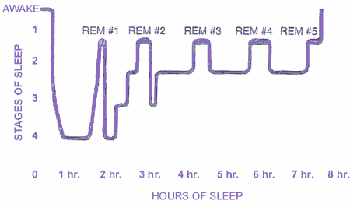The stages in the sleep cycle are organized by the changes in specific brain activity.

Stage 1 NREM:
You are entering into light sleep. This stage is characterized by:
- Non-rapid eye movements (NREM)
- muscle relaxation
- lowered body temperature
- slowed heart rate.
The body is preparing to enter into deep sleep.
Stage 2 REM:
This stage is characterized by:
- further drop in body temperature
- relaxation of the muscles
The body's immune system goes to work on repairing the day's damage. The endocrine glands secrete growth hormones, while blood is sent to the muscles to be reconditioned. In this stage, you are completely asleep.
Stage 3 NREM:
Still in the NREM stage, this is a deeper sleep still. Your metabolic levels are extremely slow.
In this stage of sleep, your eyes move back and forth erratically as if watching something from underneath your eyelids. Referred to as REM sleep or delta sleep,this stage occurs at about 90-100 minutes after the onset of sleep.Your blood pressure rises, heart rate speeds up, respiration becomes erratic and brain activity increases. Your involuntary muscles also become paralyzed or immobilized. This stage is the most restorative part of sleep. Your mind is being revitalized and emotions is being fine tuned. The majority of your dreaming occurs in this stage. If you are awakened during this stage of sleep, you are more likely to remember your dreams.
These stages repeat themselves throughout the night as you sleep. As the cycle repeats, you will spend less time in stages 1 to 3 and more time in stage 4 dreaming. In other words, it will quicker and quicker for you to get to stage 4 each time

 The Mechanics of Dreaming
The Mechanics of DreamingWhile you are dreaming, your body has some noticeable changes. Your adrenaline rises, your blood pressure increases, and you heart beats faster. Given this notion, it makes sense why some with a weak heart may die in their sleep. Their heart may not have been able to withstand the strain of the erratic changes in your breathing and heart rates that occurs during the dream state. Dreaming takes place during REM, which stands for Rapid Eye Movement. It is thus called, because your eyes move rapidly back and forth under the eyelids. REM sleep takes place in the fourth stage of sleep and accounts for 15-20% of our sleep time. From the point you fall asleep, it takes 30-90 minutes before you start dreaming. We cycle through the 4 stages of sleep and may enter the REM stage 4-7 times in one night. During REM, your blood pressure and heart rate fluctuate and increase. It sounds like your body is going through a lot. In fact, it is quite the contrary. During REM, your bodies are completely immobile and your muscles remain completely relaxed. You may shift in your bed throughout the night, but this does not happen when you are in REM. This is commonly known as "REM Paralysis".
In REM sleep, the mind is as active as it is during waking. However, chemically it is different. REM is controlled by the excitability level of the cholinergic neruons. Noradrenaline and seretonin are missing in the brain when in the dream state. These chemicals allow the brain to carry out task, solve problems and remember things. This is a reason why we find it so hard to remember our dreams.
This article was taken from: dreammoods



0 SHARE UR COMMENTS:
Post a Comment